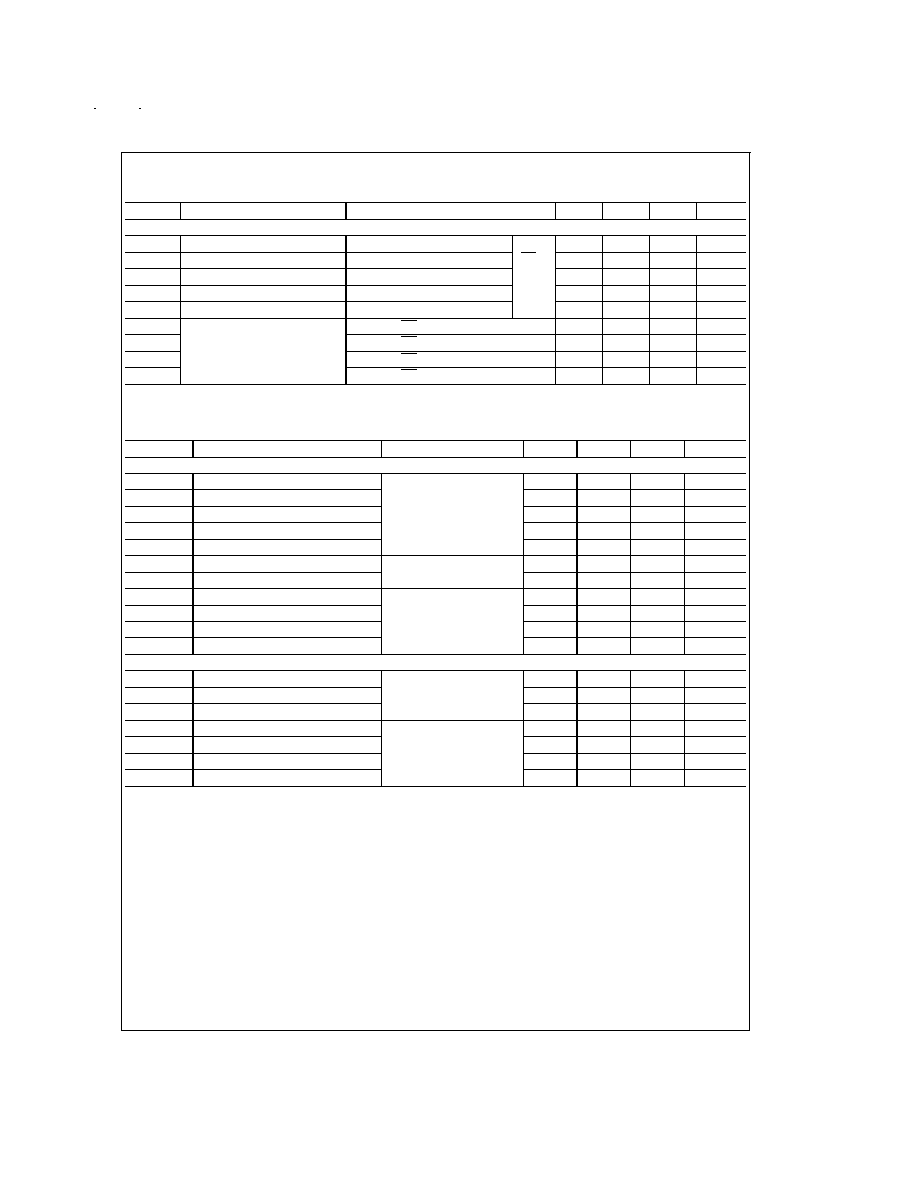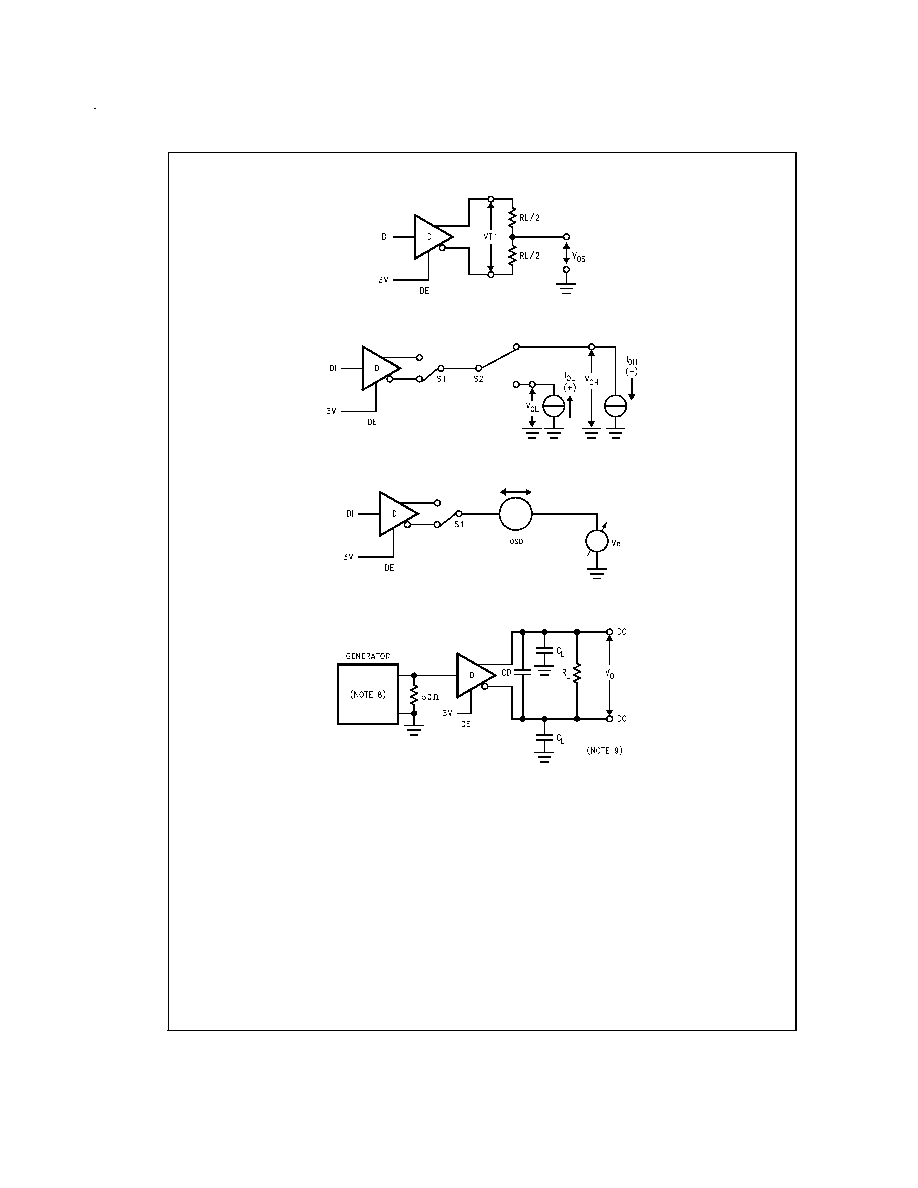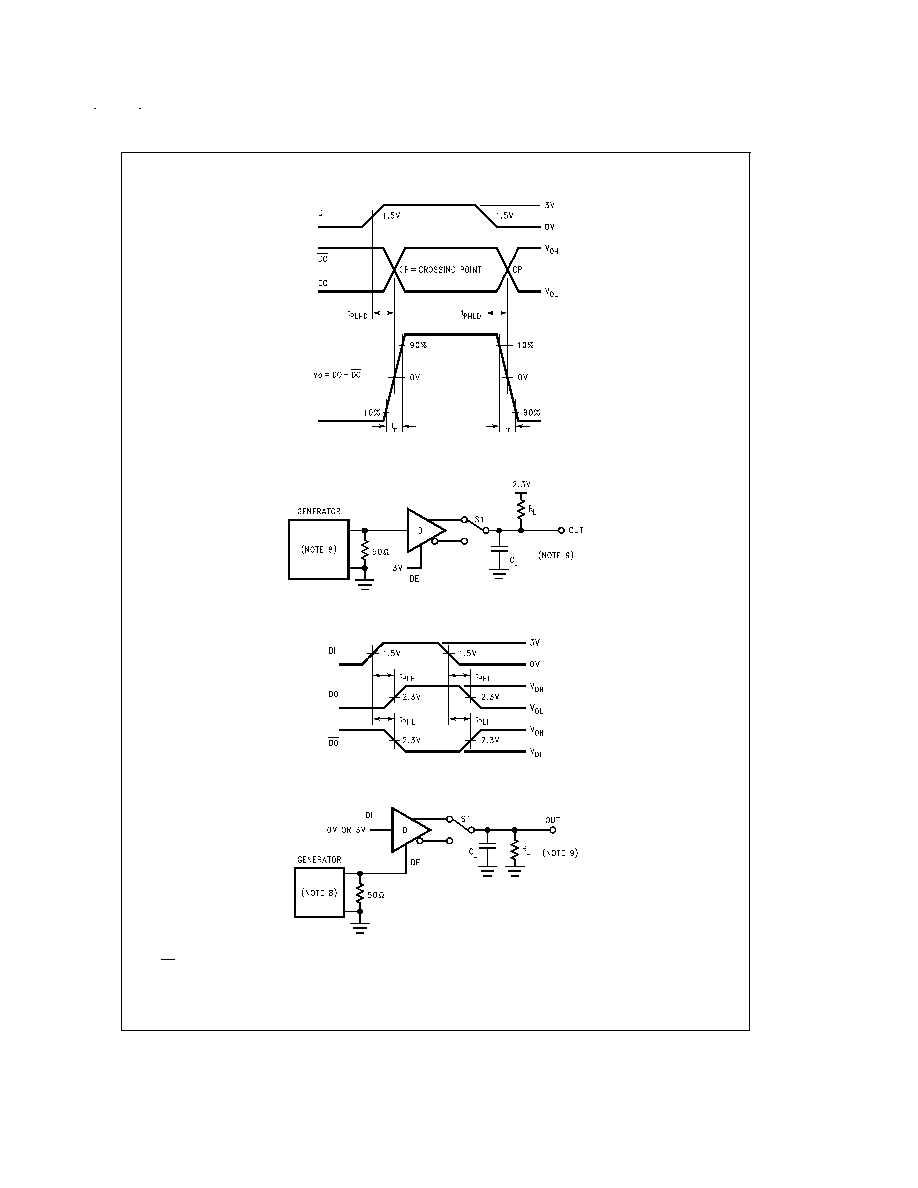
DS36276
FAILSAFE Multipoint Transceiver
General Description
The DS36276 FAILSAFE Multipoint Transceiver is designed
for use on bi-directional differential busses. It is compatible
with existing TIA/EIA-485 transceivers, however, it offers an
additional feature not supported by standard transceivers.
The FAILSAFE feature guarantees the receiver output to a
known state when the Interface is in the following conditions:
Floating Line, Idle Line (no active drivers), and Line Fault
conditions (open or short). The receiver output is in a HIGH
state for the following conditions: OPEN Inputs, Terminated
Inputs (50
), and SHORTED Inputs.
FAILSAFE is a highly desirable feature when the transceiv-
ers are used with Asynchronous Controllers such as UARTs.
Features
n
FAILSAFE receiver, RO = HIGH for:
-- OPEN inputs
-- Terminated inputs
-- SHORTED inputs
n
Compatible with popular interface standards:
-- TIA/EIA-485 (RS-485)
-- TIA/EIA-422-A (RS-422-A)
-- CCITT Recommendation V.11
n
Bi-Directional Transceiver
-- Designed for multipoint transmission
n
Separate driver input, driver enable, receiver enable,
and receiver output for maximum flexibility
n
Wide bus common mode range
-- (-7V to +12V)
n
Pin compatible with: DS75176B, DS96176, DS3695 and
SN75176A and B
n
Available in SOIC package
Connection and
Logic Diagram
Truth Tables
Driver
Inputs
Outputs
RE
DE
DI
DO/RI
DO /RI
X
H
H
H
L
X
H
L
L
H
X
L
X
Z
Z
Receiver
Inputs
Output
RE
DE
RI�RI
RO
L
L
0V
H
L
L
-500 mV
L
H
X
X
Z
Receiver FAILSAFE
Inputs
Output
RE
DE
RI�RI
RO
L
L
SHORTED
H
L
L
OPEN
H
H
X
X
Z
TRI-STATE
�
is a registered trademark of National Semiconductor Corporation.
DS011383-1
Order Number DS36276M
See NS Package Number M08A
July 1998
DS36276
F
AILSAFE
Multipoint
T
ransceiver
� 1999 National Semiconductor Corporation
DS011383
www.national.com

Absolute Maximum Ratings
(Note 1)
If Military/Aerospace specified devices are required,
please contact the National Semiconductor Sales Office/
Distributors for availability and specifications.
Supply Voltage (V
CC
)
7V
Input Voltage (DE, RE , and DI)
5.5V
Driver Output Voltage/
Receiver Input Voltage
-10V to +15V
Receiver Output Voltage (RO)
5.5V
Maximum Package Power Dissipation
@
+25�C
M Package
(derate 5.8 mW/�C above
+25�C)
726 mW
Storage Temperature Range
-65�C to +150�C
Lead Temperature (Soldering 4
sec.)
260�C
Max Junction Temperature
150�C
ESD Rating (HBM, 1.5 k
, 100
pF)
6.0 kV
Recommended Operating
Conditions
Min
Max
Units
Supply Voltage, V
CC
4.75
5.25
V
Bus Voltage
-7
+12
V
Operating Temperature (T
A
)
DS36276
0
+70
�C
Electrical Characteristics
(Notes 2, 4)
Over recommended Supply Voltage and Operating Temperature ranges, unless otherwise specified.
Symbol
Parameter
Conditions
Min
Typ
Max
Units
DRIVER CHARACTERISTICS
V
OD
Differential Output Voltage
I
O
= 0 mA (No Load)
1.5
4.8
6.0
V
V
oDO
Output Voltage
I
O
= 0 mA (Output to GND)
0
6.0
V
V
oDO
Output Voltage
0
6.0
V
V
T1
Differential Output Voltage
(Termination Load)
R
L
= 54
(485)
(
Figure 1)
1.5
2.0
5.0
V
R
L
= 100
(422)
2.0
2.3
5.0
V
V
T1
Balance of V
T1
|V
T1
| - |V
T1
|
R
L
= 54
(Note 3)
-0.2
0.07
+0.2
V
R
L
= 100
-0.2
0.07
+0.2
V
V
OS
Driver Common Mode
Output Voltage
R
L
= 54
(
Figure 1)
0
2.5
3.0
V
R
L
= 100
0
2.3
3.0
V
V
OS
Balance of V
OS
|V
OS
| - |V
OS
|
R
L
= 54
(Note 3)
-0.2
0.08
+0.2
V
R
L
= 100
-0.2
0.08
+0.2
V
I
OSD
Driver Short-Circuit
Output Current
V
O
= +12V
(
Figure 3)
134
290
mA
V
O
= V
CC
140
mA
V
O
= 0V
-140
mA
V
O
= -7V
-180
-290
mA
RECEIVER CHARACTERISTICS
V
TH
Differential Input High
Threshold Voltage (Note 5)
V
O
= V
OH
, I
O
= -0.4 mA
-7V
V
CM
+12V
-0.18
0
V
V
TL
Differential Input Low
Threshold Voltage (Note 5)
V
O
= V
OL
, I
O
= 8.0 mA
-7V
V
CM
+12V
-0.5
-0.23
V
V
HST
Hysteresis (Note 6)
V
CM
= 0V
50
mV
I
IN
Line Input Current
(V
CC
= 4.75V, 5.25V, 0V)
Other Input = 0V
DE = V
IH
(Note 7)
V
I
= +12V
0.7
1.0
mA
V
I
= -7V
-0.5
-0.8
mA
I
OSR
Short Circuit Current
V
O
= 0V
RO
-5.0
-30
-85
mA
I
OZ
TRI-STATE
�
Leakage Current
V
O
= 0.4 to 2.4V
-20
+20
�A
V
OH
Output High Voltage
(
Figure 12)
V
ID
= 0V, I
OH
= -0.4 mA
2.5
3.5
V
V
ID
= OPEN, I
OH
= -0.4 mA
2.5
3.5
V
V
OL
Output Low Voltage
(
Figure 12 )
V
ID
= -0.5V, I
OL
= +8 mA
0.25
0.6
V
V
ID
= -0.5V, I
OL
= +16 mA
0.35
0.7
V
R
IN
Input Resistance
12
19
k
www.national.com
2

Electrical Characteristics
(Notes 2, 4) (Continued)
Over recommended Supply Voltage and Operating Temperature ranges, unless otherwise specified.
Symbol
Parameter
Conditions
Min
Typ
Max
Units
DEVICE CHARACTERISTICS
V
IH
High Level Input Voltage
DE,
RE,
or
DI
2.0
V
CC
V
V
IL
Low Level Input Voltage
GND
0.8
V
I
IH
High Level Input Current
V
IH
= 2.4V
20
�A
I
IL
Low Level Input Current
V
IL
= 0.4V
-100
�A
V
CL
Input Clamp Voltage
I
CL
= -18 mA
-0.75
-1.5
V
I
CC
Output Low Voltage
Supply Current
(No Load)
DE = 3V, RE = 0V, DI = 0V
42
60
mA
I
CCR
DE = 0V, RE = 0V, DI = 0V
28
45
mA
I
CCD
DE = 3V, RE = 3V, DI = 0V
43
60
mA
I
CCX
DE = 0V, RE = 3V, DI = 0V
31
50
mA
Switching Characteristics
(Note 4)
Over recommended Supply Voltage and Operating Temperature ranges, unless otherwise specified.
Symbol
Parameter
Conditions
Min
Typ
Max
Units
DRIVER CHARACTERISTICS
t
PLHD
Diff. Prop. Delay Low to High
R
L
= 54
C
L
= 50 pF
C
D
= 50 pF
(
Figures 4, 5)
7
21
60
ns
t
PHLD
Diff. Prop. Delay High to Low
7
19
60
ns
t
SKD
Diff. Skew (|t
PLHD
�t
PHLD
|)
2
10
ns
t
r
Diff. Rise Time
12
50
ns
t
f
Diff. Fall Time
12
50
ns
t
PLH
Prop. Delay Low to High
R
L
= 27
, C
L
= 15 pF
(
Figures 6, 7)
22
45
ns
t
PHL
Prop. Delay High to Low
22
45
ns
t
PZH
Enable Time Z to High
R
L
= 110
C
L
= 50 pF
(
Figure 8 � Figure 11)
32
55
ns
t
PZL
Enable Time Z to Low
32
65
ns
t
PHZ
Disable Time High to Z
22
55
ns
t
PLZ
Disable Time Low to Z
16
55
ns
RECEIVER CHARACTERISTICS
t
PLH
Prop. Delay Low to High
V
ID
= -1.5V to +1.5V
C
L
= 15 pF
(
Figures 13, 14)
15
40
70
ns
t
PHL
Prop. Delay High to Low
15
42
70
ns
t
SK
Skew (|t
PLH
�t
PHL
|)
2
15
ns
t
PZH
Enable Time Z to High
C
L
= 15 pF
(
Figures 15, 16)
15
50
ns
t
PZL
Enable Time Z to Low
17
50
ns
t
PHZ
Disable Time High to Z
24
50
ns
t
PLZ
Disable Time Low to Z
19
50
ns
Note 1: "Absolute Maximum Ratings"are those values beyond which the safety of the device cannot be guaranteed. They are not meant to imply that the devices
should be operated at these limits. The tables of "Electrical Characteristics" specify conditions for device operation.
Note 2: Current into device pins is defined as positive. Current out of device pins is defined as negative. All voltages are referenced to ground unless otherwise speci-
fied.
Note 3:
|V
T1
| and
|V
OS
| are changes in magnitude of V
T1
and V
OS
, respectively, that occur when the input changes state.
Note 4: All typicals are given for V
CC
= 5.0V and T
A
= +25�C.
Note 5: Threshold parameter limits specified as an algebraic value rather than by magnitude.
Note 6: Hysteresis defined as V
HST
= V
TH
- V
TL
.
Note 7: I
IN
includes the receiver input current and driver TRI-STATE leakage current.
www.national.com
3

Parameter Measurement Information
DS011383-2
FIGURE 1. Driver V
T1
and V
OS
Test Circuit
DS011383-3
FIGURE 2. Driver V
OH
and V
OL
Test Circuit
DS011383-4
FIGURE 3. Driver Short Circuit Test Circuit
DS011383-5
FIGURE 4. Driver Differential Propagation Delay and Transition Time Test Circuit
www.national.com
4

Parameter Measurement Information
(Continued)
DS011383-6
FIGURE 5. Driver Differential Propagation Delays and Transition Times
DS011383-7
FIGURE 6. Driver Propagation Delay Test Circuit
DS011383-8
FIGURE 7. Driver Propagation Delays
DS011383-9
S1 to DO for DI = 3V
S1 to DO for DI = 0V
FIGURE 8. Driver TRl-STATE Test Circuit (t
PZH
, t
PHZ
)
www.national.com
5




